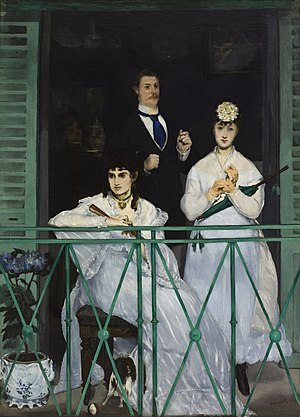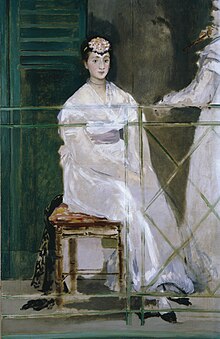The balcony (Manet)

|
| The balcony |
|---|
| Édouard Manet , 1868–69 |
| Oil on canvas |
| 169 × 125 cm |
| Musée d'Orsay, Paris |
The balcony (French: Le Balcon) is a picture by the painter Édouard Manet . It was created in 1868–69 and shows two women and a man on a balcony . Three friends of the painter were the models: Berthe Morisot , who married Manet's brother in 1877, the violinist Fanny Claus and the painter Antoine Guillemet . It is believed that Manet's balcony recreated Francisco de Goya's motif Mayas on a balcony from 1810 to 1815.
description
Four people can be seen on the screen. Berthe Morisot sits in the left foreground. She wears a white dress, the transparency of which lets the left forearm shine through and whose opulent fullness otherwise completely conceals the body shape. The Morisot's hands hold a closed fan, as if the sun had disappeared behind clouds, so that, contrary to expectations, there is no need to fan coolness. A black-and-white piebald dog can be seen between the legs of the chair on which she is sitting, peering through the bars of the balcony railing into the street. Apparently he's the only one really looking for something. A little set back in the right half of the picture we see Fanny Claus, who is reported to have argued with Berthe Morisot about the privilege of who was allowed to position himself at the very front of the painting while standing as a model. In the oil sketch Portrait of Mademoiselle Claus , Fanny Claus still takes the seated position. Fanny Claus also wears white, but less lush than the winner for the place in the foreground of the picture. In the middle behind the women, whose postures turned away from each other seem to indicate that they have not yet forgiven the argument, we recognize Antoine Guillemet, correctly wearing a dark frock coat, white shirt and blue tie. With a lit cigarette in his left hand he stands there like a representative of the satisfied bourgeoisie , less busy looking at something than being recognized by any passers-by on the street as a worthy patron. The fourth person almost disappears into the darkness of the room, the contours of which can hardly be guessed. It appears to be a servant carrying a silver tea kettle. In addition to the white that envelops the women and the black of the frock coat and the indefinite darkness of the room, you can see a lot of green in the picture. What is meant is not the green of the hydrangea , which needs a little space to the left of Berthe Morisot, but the paintwork of the shutters and balcony railings.
Reaction to criticism
After all, in contrast to many other pictures by Manet, the picture was accepted by the Paris Salon . But this time too, this did not protect the painter from being rejected by the majority of his critics. On May 27, 1869, Louis Renault scoffed that it was Manet's specialty to frighten the bourgeoisie with intentional ugliness. Arthur de Boissieu advised the painter to stay unknown and the writer Théophile Gautier , who in turn flooded his reading contemporaries with tidal waves of Baroque details, condescendingly said that Manet could become a good painter if he tried harder.
Manet and Goya's interpretation of the subject
59 years before Manet, Goya painted four people on a balcony. While the characters of Manet look in different directions, as if they had nothing more to do with each other than to pose for the same painter, Goya's group has a completely different dynamic. His four are not called together by the tea brought by a servant. Rather, they are centered towards the center of the picture, as if they had a conspiratorial agreement that is coming together against a common threat from outside. Accordingly, the colors of Manet appear cool, while Goya's dark red seems to betray the passion that welds the alliance of the four people together.
literature
- Ina Conzen: Edouard Manet and the Impressionists , Hatje Cantz Verlag 2002, ISBN 3-7757-1201-1 .
- Hajo Düchting: Manet, Pariser Leben , Prestel Verlag, Munich 1995, ISBN 3-7913-1445-9 .
- Pierre Courthion: Manet , DuMont Buchverlag, Cologne 1990, ISBN 3-7701-2598-3 .

